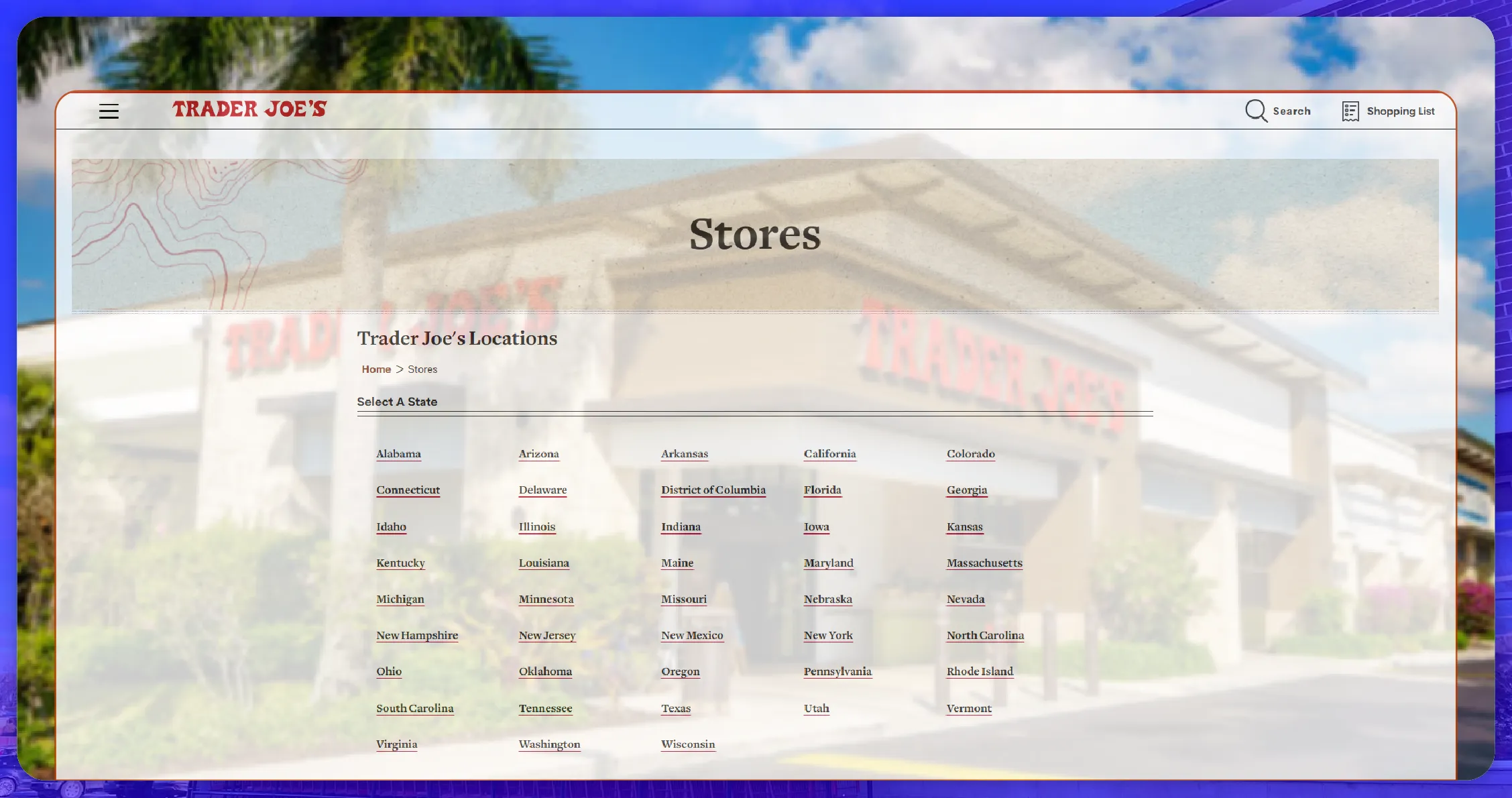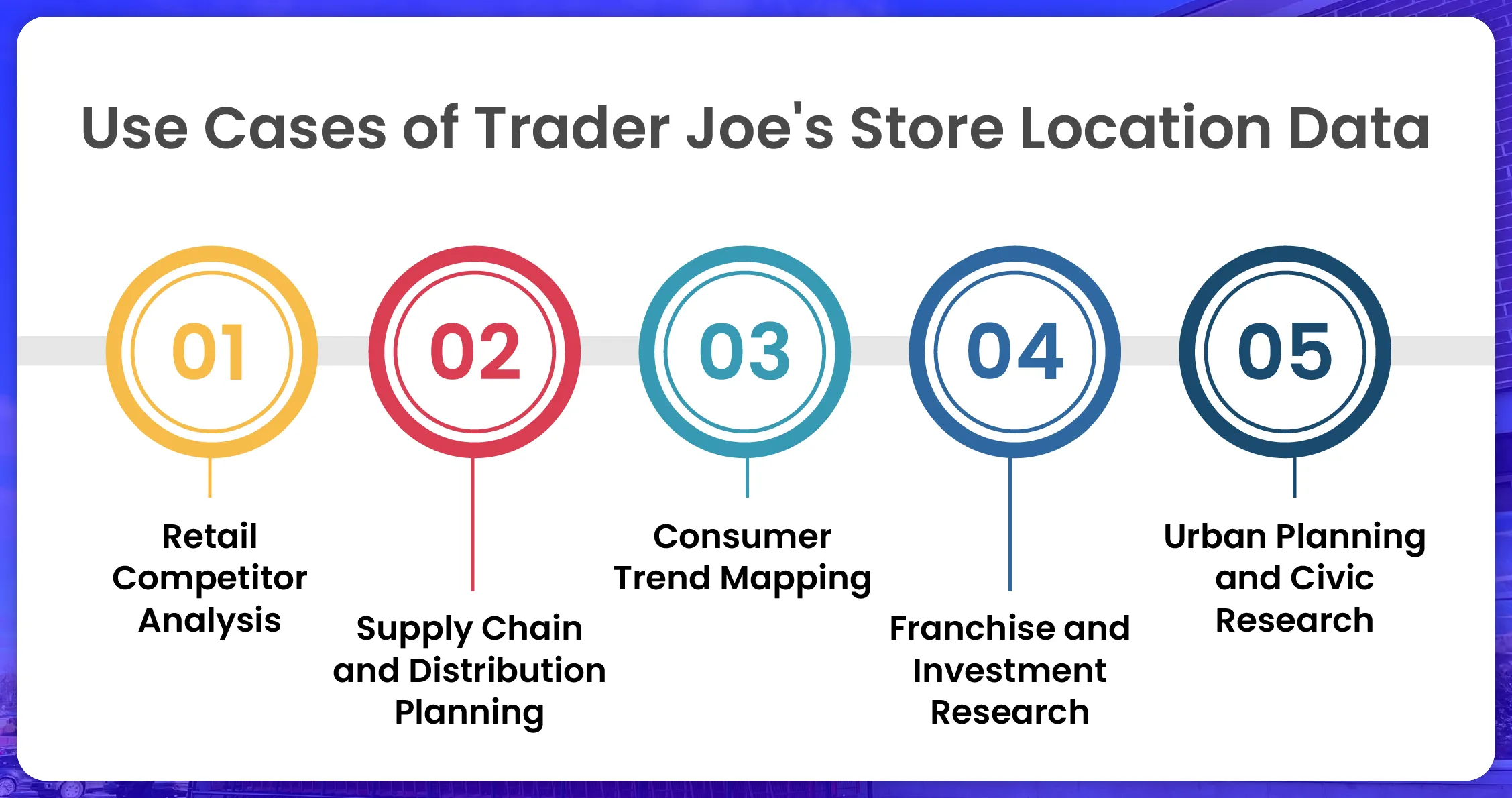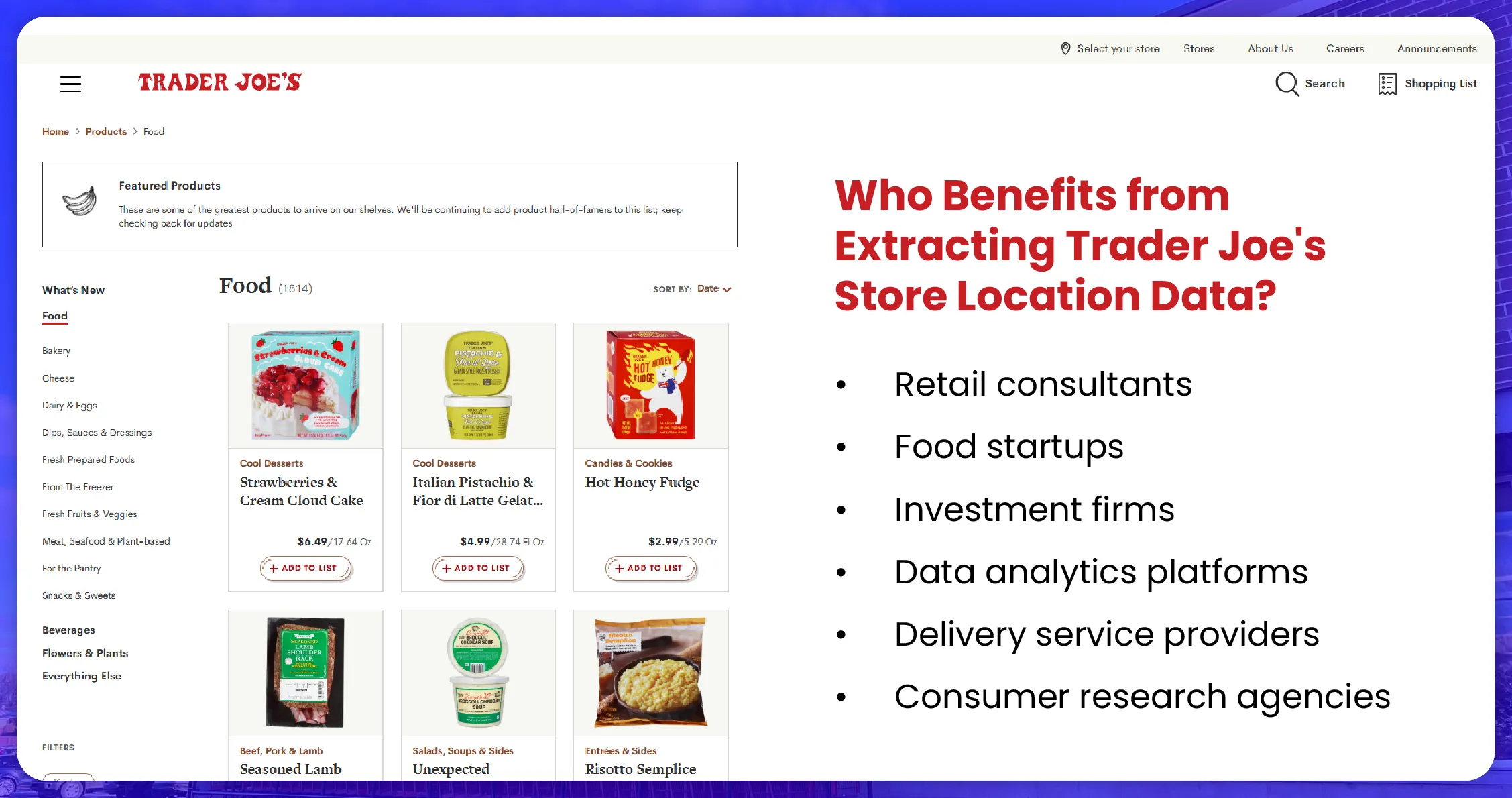What Insights Can You Gain When You Extract Trader Joe's Grocery Store Location Data?
Introduction
Trader Joe's is arguably one of the most unique grocery chains in America, with passionate customer loyalty, unbeatable prices, private-label products, and a great selection of healthy options. While the store's tropical vibes and passionate staff add to the fun, a tremendous strategic asset often unnoticed by Trader Joe's customers is store location data. Companies and analysts that want to solve market questions and retail trends can Extract Trader Joe's Grocery Store Location Data to gain insight on demand by region, neighborhood demands, and proximity to competitors. No matter what your role - whether you're a retail analyst, logisticist, or investor - using Trader Joe's Grocery Store Locator Data Scraper tools is unmatched intelligence. In addition, Web Scraping Trader Joe's for Location Insights can help companies monitor store growth, catch saturation by geography, and assess their growth potential. Anyone looking to be near a Trader Joe's shopping footprint, refine their go-to-market strategy, or watch the evolving consumer geography would find this information highly valuable.
Why Extracting Store Location Data Matters?
 Trader Joe's follows a distinct retail model built on fewer SKUs, highly curated inventory, and carefully chosen store locations. These locations aren't randomly selected—they result from deliberate market research and demographic targeting. Analyzing the Trader Joe's Grocery Store Location Dataset can reveal the brand's expansion logic and regional priorities. For stakeholders in food delivery, CPG brands, or retail analytics, this data provides a strategic blueprint for understanding where Trader Joe's sees strong consumer potential. Additionally, gaps in the store footprint highlight untapped markets and expansion white spaces. With Trader Joe's Grocery Store Geolocation Data Scraping, companies gain a competitive edge by identifying high-opportunity zones and consumer clusters. When businesses Scrape Trader Joe's Store Addresses and Zip Codes, they can overlay this data with delivery coverage, consumer demand trends, or local retail competition to build smarter, data-backed marketing, logistics, and regional growth strategies.
Trader Joe's follows a distinct retail model built on fewer SKUs, highly curated inventory, and carefully chosen store locations. These locations aren't randomly selected—they result from deliberate market research and demographic targeting. Analyzing the Trader Joe's Grocery Store Location Dataset can reveal the brand's expansion logic and regional priorities. For stakeholders in food delivery, CPG brands, or retail analytics, this data provides a strategic blueprint for understanding where Trader Joe's sees strong consumer potential. Additionally, gaps in the store footprint highlight untapped markets and expansion white spaces. With Trader Joe's Grocery Store Geolocation Data Scraping, companies gain a competitive edge by identifying high-opportunity zones and consumer clusters. When businesses Scrape Trader Joe's Store Addresses and Zip Codes, they can overlay this data with delivery coverage, consumer demand trends, or local retail competition to build smarter, data-backed marketing, logistics, and regional growth strategies.Use Cases of Trader Joe's Store Location Data
 Trader Joe’s store location data provides valuable insights for businesses, analysts, and logistics teams. From identifying high-performing retail zones to planning delivery routes and competitor analysis, this data supports smarter decision-making. Understanding where Trader Joe’s operates helps uncover demographic trends, optimize store placement strategies, and enhance market expansion efforts.
Trader Joe’s store location data provides valuable insights for businesses, analysts, and logistics teams. From identifying high-performing retail zones to planning delivery routes and competitor analysis, this data supports smarter decision-making. Understanding where Trader Joe’s operates helps uncover demographic trends, optimize store placement strategies, and enhance market expansion efforts.- Retail Competitor Analysis: One of the most immediate applications of store location data is benchmarking against competitors. Retail chains such as Whole Foods, Sprouts Farmers Market, Aldi, or even mainstream players like Walmart and Kroger often compete with Trader Joe's for the same demographic: educated, health-conscious, urban or suburban consumers. Mapping Trader Joe's locations enables comparative geographic studies. Retail chains can assess if they're overexposed in some regions or missing presence in high-opportunity zones where Trader Joe's thrives. Scrape Online Trader Joe's Grocery Delivery App Data to layer store presence with app-based consumer engagement for a deeper competitive edge.
- Supply Chain and Distribution Planning: Trader Joe's unique product offering and private-label ecosystem means they operate on tight distribution networks. By extracting store location data, logistics providers, warehouse managers, and CPG brands can determine proximity to distribution centers or routes for third-party logistics. A brand aiming to pitch its product to Trader Joe's must consider how regional distribution would work. For instance, if the East Coast-based brand is eyeing Trader Joe's hubs in Texas or California, the logistics model must shift accordingly. Here, Trader Joe's Grocery Delivery Scraping API Services help simulate delivery feasibility and regional scalability aligned with store geography.
- Consumer Trend Mapping: Locations tell stories. When plotted on a map and combined with other demographic or psychographic data, Trader Joe's store locations become markers of consumer behavior. Are Trader Joe's more prevalent in areas with younger populations? Higher education levels? Affluent suburbs? The answers allow marketers to make data-driven assumptions. Grocery App Data Scraping Services can integrate these insights by combining physical store data with mobile app usage patterns. This enables marketing agencies and CPG companies to refine their personas and target highly responsive customer segments with tailored strategies.
- Franchise and Investment Research: Trader Joe's has no franchise, but its location data is a goldmine for investors and entrepreneurs developing new retail formats. Where Trader Joe's opens, increased foot traffic and surrounding commercial growth often follow. By analyzing store location data, investors can strategically plan adjacent or complementary business models—boutique fitness centers, coffee shops, or specialty food startups. Web Scraping Quick Commerce Data helps identify which regions have overlapping consumer interests in health, convenience, and premium food, informing investment and site selection decisions.
- Urban Planning and Civic Research: For urban planners, sociologists, and academic researchers, Trader Joe's store presence often signals gentrification or economic transformation. City planners and real estate economists can extract store location data and cross-reference it with housing trends, infrastructure development, and local economic shifts. Trader Joe's often precedes real estate appreciation and lifestyle shifts in major metros like Los Angeles, Atlanta, or Chicago. Utilizing Grocery Delivery Scraping API Services, researchers can track where stores are opening and where digital grocery behavior is intensifying, creating a broader understanding of urban consumer evolution and retail-driven civic change.
Enriching the Dataset: What Comes Next?
Extracting raw latitude-longitude points or addresses is just the starting point. The true power of this dataset comes when it's enriched with additional layers:
- • Demographic overlays : Population density, age distribution, education levels.
- • Proximity analysis: Distance from competitors like Whole Foods or Sprouts.
- • Traffic data: Footfall analytics, driving accessibility, and parking availability.
- • Sales proxies: Yelp reviews, Google Maps ratings, and social media mentions.
- • Real estate overlays: Rental price trends, property values, zoning classifications.
Combined, these elements create a multidimensional understanding of why Trader Joe's is where it is and where it might go next.
Who Benefits from Extracting Trader Joe's Store Location Data?
 The demand for this data spans multiple industries:
The demand for this data spans multiple industries:Examples:
- Retail consultants seeking store placement recommendations.
- Food startups assessing target markets for regional rollouts.
- Investment firms eyeing trends in neighborhood growth.
- Data analytics platforms looking to build geo-targeted insights dashboards.
- Delivery service providers optimize last-mile logistics.
- Consumer research agencies enhancing buyer persona frameworks.
Even established CPG brands use such data to plan trade marketing strategies, knowing which areas to deploy sampling campaigns, in-store promotions, or influencer marketing campaigns.
Building Strategic Intelligence
 While Trader Joe's does not publicize sales figures or detailed performance metrics, its store location data is a form of strategic communication. It's a visible output of its market research, internal forecasts, and brand confidence. Third-party observers can extract this data to reverse engineer patterns that inform key business decisions.
While Trader Joe's does not publicize sales figures or detailed performance metrics, its store location data is a form of strategic communication. It's a visible output of its market research, internal forecasts, and brand confidence. Third-party observers can extract this data to reverse engineer patterns that inform key business decisions.For instance, if Trader Joe's opens multiple new stores in Florida quickly, it could indicate shifting population trends or growing demand for value-conscious health food in that region. Similarly, a prolonged absence in fast-growing cities like Nashville or Charlotte may suggest logistical challenges or deliberate market avoidance. These patterns reveal strategic levers that conventional research may not immediately reveal.
Data as a Decision-Making Catalyst
 When converted into interactive maps, dashboards, or business intelligence models, stored location data becomes a tool for fast decision-making. Brands can quickly pivot strategies based on real-world insights. Is there a cluster of Trader Joe's stores underserved by delivery apps? Is there a concentration of stores in college towns signaling a younger audience? Such revelations can be visualized through a Grocery Price Dashboard, allowing companies to align location data with pricing trends and competitive positioning for greater precision in marketing and operations.
When converted into interactive maps, dashboards, or business intelligence models, stored location data becomes a tool for fast decision-making. Brands can quickly pivot strategies based on real-world insights. Is there a cluster of Trader Joe's stores underserved by delivery apps? Is there a concentration of stores in college towns signaling a younger audience? Such revelations can be visualized through a Grocery Price Dashboard, allowing companies to align location data with pricing trends and competitive positioning for greater precision in marketing and operations.Moreover, in an age where digital and physical retail continue to blend, knowing Trader Joe's physical footprint helps brands balance their omnichannel presence. A DTC (direct-to-consumer) food brand might notice that areas with Trader Joe's also show higher conversion rates on their e-commerce platform—suggesting that consumer trust built in-store spills into online behavior. Tools like a Grocery Price Tracking Dashboard further support this strategy by monitoring real-time pricing patterns across geographic clusters.
How Food Data Scrape Can Help You?
- Hyper-Localized Market Intelligence: Our scraping solutions extract granular data such as store locations, pricing, and availability—helping businesses make region-specific decisions and uncover local trends faster than ever.
- Real-Time Retail Monitoring: By continuously tracking changes in store data, menus, products, or delivery availability, we empower companies to respond instantly to shifts in consumer demand and competitor activity.
- Customizable and Scalable Solutions: Whether it's hundreds of grocery stores or thousands of product listings, our services scale with your data needs and integrate seamlessly into your analytics pipeline.
- Multi-Platform Integration: From web portals to delivery apps, our scrapers collect comprehensive datasets across sources, offering a unified view of physical and digital commerce ecosystems.
- Driving Strategy with Actionable Insights: Businesses rely on our data to power dashboards, optimize supply chains, map expansion opportunities, and build customer intelligence models—making data accessible and truly strategic.
Conclusion
Extracting Trader Joe's grocery store location data is more than a technical task—it's a gateway to understanding a powerful, trend-setting retailer and its relationship with American consumers. Whether tracking urban revitalization, preparing your brand's expansion, or mapping where grocery innovation is thriving, this dataset provides the foundational layer for meaningful strategic insights through comprehensive Grocery Store Datasets.
In an increasingly competitive and data-driven retail environment, understanding where—and why—Trader Joe's operates empowers businesses to stay ahead, adapt faster, and make smarter decisions rooted in geographic intelligence. When combined with Grocery Pricing Data Intelligence, these insights enable precise market entry, demand forecasting, and pricing alignment that matches localized consumer behavior—turning data into actionable retail strategy.
Extracting Trader Joe's grocery store location data is more than a technical task—it's a gateway to understanding a powerful, trend-setting retailer and its relationship with American consumers. Whether tracking urban revitalization, preparing your brand's expansion, or mapping where grocery innovation is thriving, this dataset provides the foundational layer for meaningful strategic insights.
In an increasingly competitive and data-driven retail environment, understanding where—and why—Trader Joe's operates empowers businesses to stay ahead, adapt faster, and make smarter decisions rooted in geographic intelligence.
Are you in need of high-class scraping services? Food Data Scrape should be your first point of call. We are undoubtedly the best in Food Data Aggregator and Mobile Grocery App Scraping service and we render impeccable data insights and analytics for strategic decision-making. With a legacy of excellence as our backbone, we help companies become data-driven, fueling their development. Please take advantage of our tailored solutions that will add value to your business. Contact us today to unlock the value of your data.
Read More >> https://www.fooddatascrape.com/grocery-mobile-app-data-scraping.php